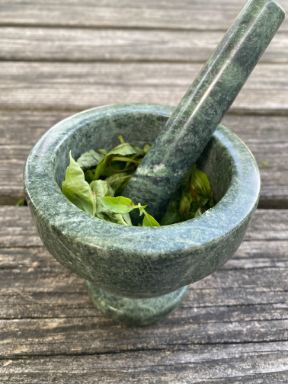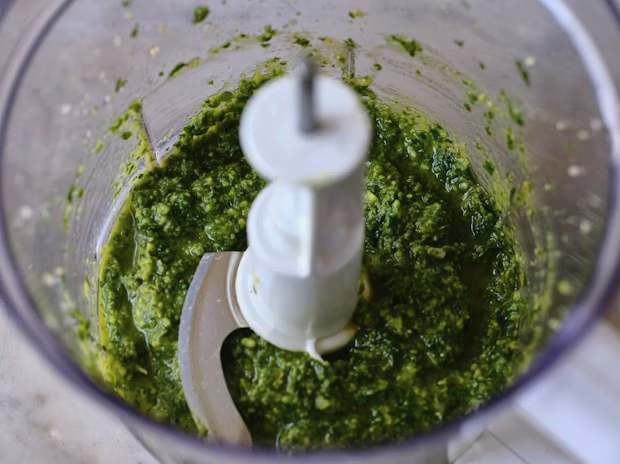Paige Knight - 05 / Jun / 2024
Pesto 101: Recipes, Tips, and Variations
Craving a burst of fresh flavor? Look no further than pesto! This vibrant sauce, traditionally made with basil, pine nuts, garlic, Parmesan cheese, and olive oil, is a versatile ingredient that can elevate countless dishes. But where do you even begin?
This Pesto 101 guide is your one-stop shop for all things pesto! We'll break down the essential elements of a classic pesto recipe, then delve into helpful tips and variations to take your pesto game to the next level.

If you’re a fan of Italian cuisine, you’ve probably rubbed elbows with a pesto or two. Traditionally made with basil, pine nuts, grated parmesan, garlic, and olive oil, pesto is an iconic sauce for Italian pastas. However, most people don’t realize that there’s more to the wide world of pesto than the traditional pesto genovese we all know and love. Take a step outside your comfort zone (if you dare) to learn about all of the wonderful ways to use pesto.
The Dichotomy of Pesto
Pesto originally comes from the Genoa region of northern Italy, its name deriving from the Italian word “pestare,” which literally means “to crush.” Really, that sums up the key to pesto: you’ve got to crush your ingredients well with a mortar and pestle, blender, or food processor.
While us Americans are fond of the food processor shortcut, Italians stand firm that a mortar and pestle is the best way to make an authentic pesto. Regardless of which you choose, most pestos are made up of a few basic ingredients:
- Leafy herbs or vegetables
- Nuts
- Grated parmesan cheese
- Garlic
- Quality olive oil
While pesto genovese is the most common, pesto comes in all shapes and sizes and can be used as anything from a sandwich spread to a sauce for meat and fish. Here are a few of our favorite non-traditional pesto ingredients.
Cilantro Pesto
Cilantro pesto is my personal favorite variation of traditional pesto genovese. It’s a bright, fresh alternative that goes great on empanadas, tacos, and even seared salmon. It’s also a great way to use up excess cilantro before it goes bad.
Cilantro Pesto Ingredients
- 1 cup tightly-packed cilantro leaves
- ½ cup nuts of choice (almonds, pine nuts, or pepitas are a popular choice)
- 2 cloves of garlic
- ¼ cup gratedparmesan cheese
- ¼ cup olive oil
(optional) lime juice or jalapenos, to taste

A mortar and pestle is perfect for pesto, but it’s also great for tasks like crushing garlic, grinding spices, and whipping up a batch of guacamole.
Sun-Dried Tomato Pesto
Another popular pesto variant is a sun-dried tomato pesto. This is great for spreading on sandwiches, flavoring pastas, or even on a bruschetta. Here’s what it takes to make a killer sun-dried tomato pesto.
Sun Dried Tomato Pesto Ingredients
- 1 cup of jarred sun dried tomatoes in oil
- 2 garlic cloves
- ½ cup nuts (pine nuts, walnuts, and almonds are popular options)
- 1 cup of tightly packed basil leaves
- ¼ cup gratedparmesan cheese
- ¼ cup gratedpecorino romano
- Olive oil, as needed
- Salt and pepper, to taste
Matcha Pesto
One of the most out-there pesto varieties I’ve stumbled across, matcha pesto combines the earthiness of matcha with the fresh flavors of mint, basil, and parsley. Matcha is made of powdered green tea, boasting a number of health benefits (learn more in our tea blog!). Let’s talk about the key ingredients to a nutrient-rich matcha pesto.
Matcha Pesto Ingredients
- 1 ½ teaspoons matcha powder
- 1 cup mint leaves
- ½ cup basil leaves
- ½ cup parsley leaves
- 2 cloves garlic
- ¼ cup nuts (pine nuts, walnuts, and almonds are popular choices)
- 2 finely choppedspring onions
- ¼ cup gratedparmesan cheese
- ¼ cup gratedpecorino romano
- ½ cup olive oil
- Salt and pepper, to taste

If you don’t feel like going through the hassle of hand-grinding with a mortar and pestle, you can opt for a food processor instead.
Preparing Your Pesto of Choice
As you may have picked up, pesto is a highly versatile sauce with tons of possible flavor variations. We invite you to play with different ingredients and spices – who knows? You might even create a never-before-seen blend of your own! Whatever ingredients you choose, the process of making pesto is simple.
- Toast your nuts of choice in a frying pan on medium heat, stirring occasionally until they are fragrant and beginning to brown. Allow them to cool completely.
- Add your toasted nuts to a mortar and pestle, lightly crushing using circular movements.
- Remove your nuts, add your garlic, and grind it to a paste.
- Gradually add your leafy herbs or vegetables (plus any other solid ingredients you’re using), grinding them down to a thick paste.
- Grate your cheese and stir it into your mixture.
- Gradually add extra virgin olive oil to the mixture until it reaches your desired consistency.
Notes
- If you don’t have a mortar and pestle (or you’re not as patient as the traditional Italians), feel free to use a food processor or blender to make this process quicker.
- Store your pesto in an airtight container for up to 5 days.
- Read our spices blog to get creative with your pesto flavors.










